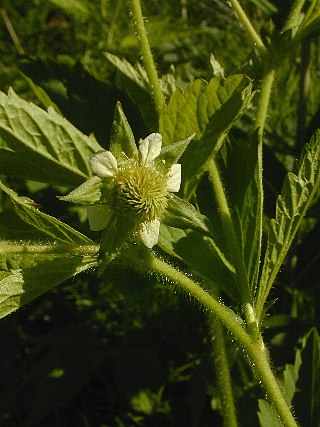Description:
This herbaceous perennial plant is 1½–2½' tall, branching occasionally.
The
round stems are light green and covered with coarse spreading hairs.
Both basal and cauline leaves are produced; the cauline leaves are
alternate, becoming smaller as they ascend the stems. The basal and
lower cauline leaves are oddly pinnate (often with 5 leaflets), while
the upper cauline leaves are
trifoliate or simple. The simple leaves
and leaflets of the compound leaves are up to 3" long and 2½" across.
They are lanceolate to ovate-oval, coarsely serrated or shallowly cleft
along the margins, and largely hairless. Sometimes the leaves and
leaflets are deeply cleft into 2 or 3 lobes. The terminal leaflet is
larger in size than the lateral leaflets. The basal and lower cauline
leaves have stout petioles, while the upper cauline leaves are nearly
sessile. At the base of each petiole, there is a pair of leafy stipules
that are cleft or dentate; each stipule is up to ½" long. The upper
stems individually terminate in 1-3 flowers; sometimes single flowers
are produced from the axils of the upper leaves. Each flower develops
from a stalk (peduncle) up to 3" long; this stalk is covered with
coarse spreading hairs. Each flower is about ½" across, consisting of 5
petals that are white or cream, 5 triangular green sepals, and several
stamens surrounding a large cluster of green carpels with elongated
styles. The petals are shorter than the sepals. The anthers are usually
dull yellow or tan. The receptacle of the flower (underneath the
carpels) is hairless or nearly so. The blooming period occurs from late
spring to mid-summer and lasts about a month. There is no noticeable
floral scent. Each flower is replaced by a spheroid cluster of achenes
with elongated styles that are hooked at their tips. This fruiting
cluster is about ¾" across; it is initially green, but eventually turns
brown. The root system consists of a taproot and rhizomes; vegetative
offsets are often formed.
cauline leaves are
trifoliate or simple. The simple leaves
and leaflets of the compound leaves are up to 3" long and 2½" across.
They are lanceolate to ovate-oval, coarsely serrated or shallowly cleft
along the margins, and largely hairless. Sometimes the leaves and
leaflets are deeply cleft into 2 or 3 lobes. The terminal leaflet is
larger in size than the lateral leaflets. The basal and lower cauline
leaves have stout petioles, while the upper cauline leaves are nearly
sessile. At the base of each petiole, there is a pair of leafy stipules
that are cleft or dentate; each stipule is up to ½" long. The upper
stems individually terminate in 1-3 flowers; sometimes single flowers
are produced from the axils of the upper leaves. Each flower develops
from a stalk (peduncle) up to 3" long; this stalk is covered with
coarse spreading hairs. Each flower is about ½" across, consisting of 5
petals that are white or cream, 5 triangular green sepals, and several
stamens surrounding a large cluster of green carpels with elongated
styles. The petals are shorter than the sepals. The anthers are usually
dull yellow or tan. The receptacle of the flower (underneath the
carpels) is hairless or nearly so. The blooming period occurs from late
spring to mid-summer and lasts about a month. There is no noticeable
floral scent. Each flower is replaced by a spheroid cluster of achenes
with elongated styles that are hooked at their tips. This fruiting
cluster is about ¾" across; it is initially green, but eventually turns
brown. The root system consists of a taproot and rhizomes; vegetative
offsets are often formed.
Cultivation:
The preference is partial sun, moist to mesic conditions, and soil
containing loam or sandy loam. Full sun and light shade are also
tolerated.
Range & Habitat:
The native Rough Avens occurs occasionally in central and northern
Illinois, but
it is absent from the southern and southwestern areas of the state (see
Distribution
Map). Habitats include savannas, thickets, woodland borders,
and moist meadows. Sometimes it is found in thickets and prairie
remnants along railroads and roadsides.
Faunal Associations:
Information about floral-faunal relationships for
this species is rather limited. They are probably similar to those of Geum
canadense (White Avens). The nectar and pollen of the flowers
probably attract small bees, wasps, and flies. Insects that feed on the
foliage of Geum spp.
(Avens) include the aphids Acyrthosiphon
pseudodirhodum, Macrosiphum
gei, Macrosiphum
pallidum, and Macrosiphum
pseudorosae. In addition, larvae of a moth, Tinagma obscurofasciella,
mine the leaves. The achenes with hooked
styles can cling to the fur of mammals, feathers of birds, and clothing
of humans; by this means, they can be distributed across considerable
distances.

Photographic
Location:
Between a thicket and prairie remnant along a railroad in Champaign
County, Illinois.
Comments:
Rough Avens blooms a little later than Geum vernum
(Spring Avens), but a little earlier than Geum canadense
(White Avens) and Geum virginianum (Pale Avens). It
can be confused with White Avens. However, Rough Avens has petals that
are shorter than the sepals and its flowering stalks have coarse
spreading hairs. White Avens has petals that are as long or longer than
the sepals and its flowering stalks are finely pubescent. Pale Avens
also has an appearance that is similar to Rough Avens; it is restricted
to southern Illinois. Pale Avens has slightly smaller flowers (about
1/3" across) with cream petals that are much shorter than the sepals.
The receptacles of its flowers are bristly-hairy, while the receptacles
of Rough Avens are hairless or nearly so.